
What is a PESTLE Analysis? A Complete PESTLE Analysis Guide
What is a PESTLE Analysis
A PESTLE analysis examines external market factors - including Political, Economic, Social, Technological, Legal, and Environmental - and market trends that might impact your organization’s direction, performance, and position in the marketplace. Used in tandem with a SWOT analysis, it helps your organization examine external factors that could influence your organization’s opportunities and threats. In this article, we’ll dig into what is a PESTLE analysis, what each factor covers, and how to use it in tandem with your SWOT.
DOWNLOAD THE FREE GUIDE

So why do I need to conduct a PESTLE Analysis?
The last few years have been a whirlwind of change and uncertainty - a global pandemic, natural disasters, looming recession, war, inflation, and more. Organizations have faced a great deal related to external market factors directly impacting their organizations. Current events have been stressful enough for any organization to worry about, whether you’re well-established or new in your market.
While the global situation is intimidating for many current and future leaders, this helpful analysis can help you assess and plan for what might impact your organization - and either seize those forces as opportunities or work to mitigate them as threats. Using a PESTLE allows you to look ahead at challenges your organization may encounter and create strategies to address them.
Pro Tip:
We covered using this tool a few years back during the start of the COVID pandemic. This article has some helpful tips on using this analysis to examine market megatrends.
The PESTLE Analysis Framework Explained
As we mentioned earlier, this analysis looks at the external Political, Environmental, Social, Technological, Legal, and Environmental factors that would influence your organization’s strengths and weaknesses. A PESTLE analysis is best used in tandem with your SWOT analysis. As demonstrated below, this framework looks at the macro-trends in your operating environment.
As you complete your planning process, this looks at the external analysis portion of your environmental scan - also known as what is happening in your market.
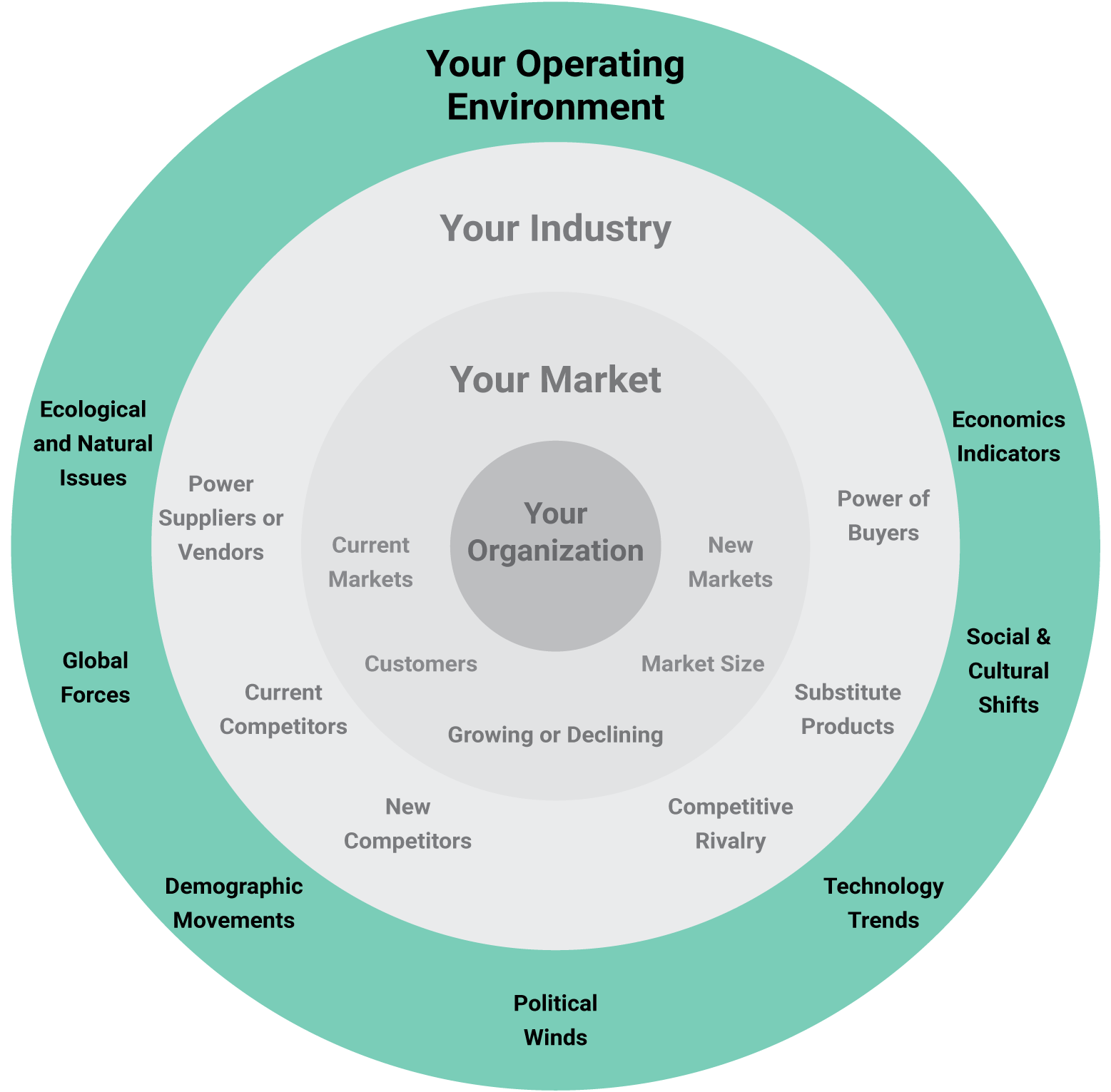
Pro Tip:
A PESTLE analysis looks at external market forces, so they will not influence your organization’s internal strengths or weaknesses. Strengths and weaknesses come from traits or characteristics your organization already processes.
What are Political factors?
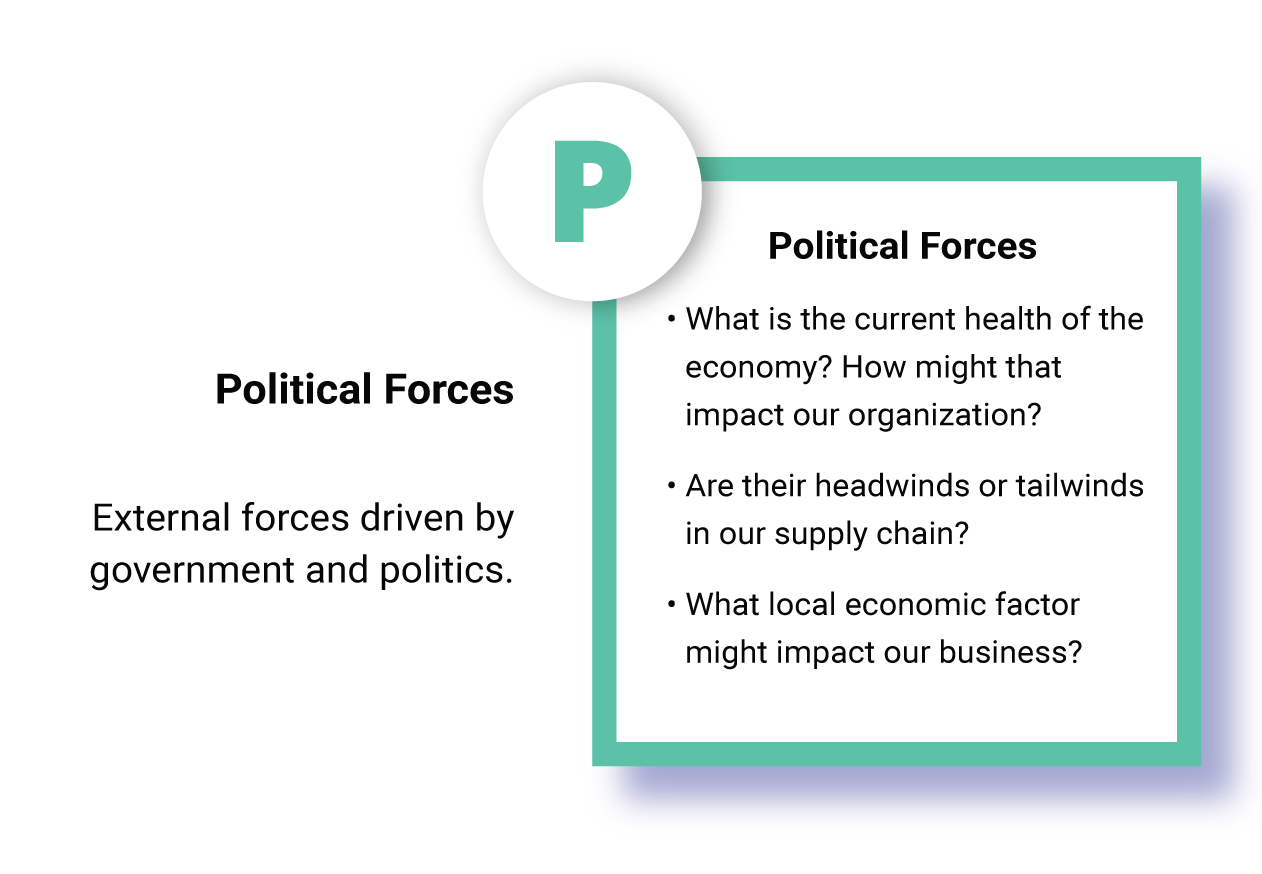
Political factors are those brought on by the government or politics. These are the external political forces affecting your organization, including governmental policies, government leadership, foreign trade and foreign relations, political issues and trends, tax policy, regulations, and de-regulation trends.
A few examples might include the influx of capital from the Paycheck Protection Plan, the change in tariffs on imports from China, and the war and conflict from Russia’s invasion of Ukraine.
Questions to ask:
- What shifts have occurred in the political climate?
- How might those shifts impact our organization? Are they headwinds, or tailwinds?
- Are they short- or long-term plays?
- What are the political threats you should monitor?
What are Economic factors?
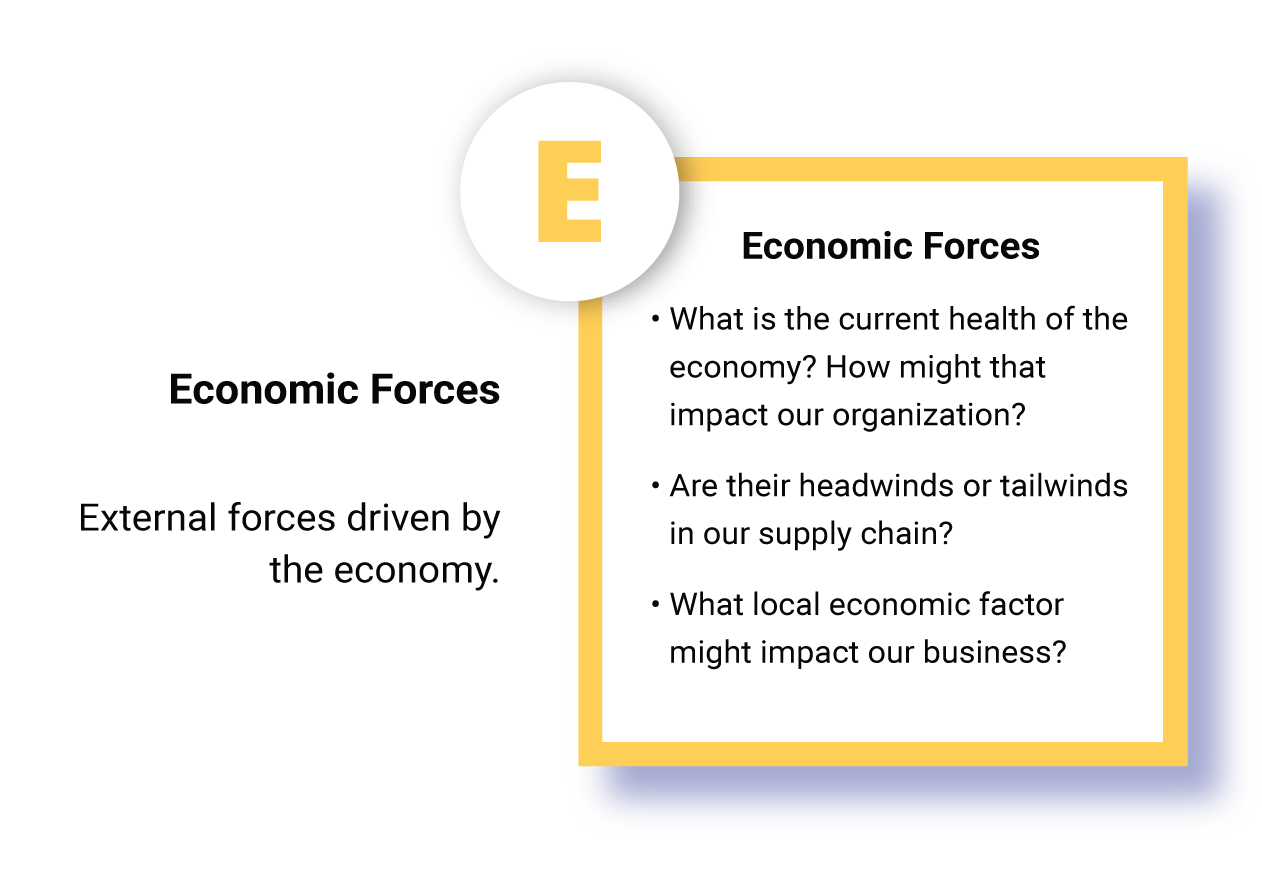
The economic factors look at the external forces that can impact the economy your organization operates in. Examples include rising inflation rates, changes and shifts in consumer spending, changes in the supply chain, demand curves, and the health of the global economy.
These economic factors can look at the local economy, national economy, and global economy.
Questions to ask:
- What is the current health of the economy? How might that impact our organization?
- Are there headwinds or tailwinds in our supply chain?
- What local economic factor might impact our business?
What are Sociological factors?
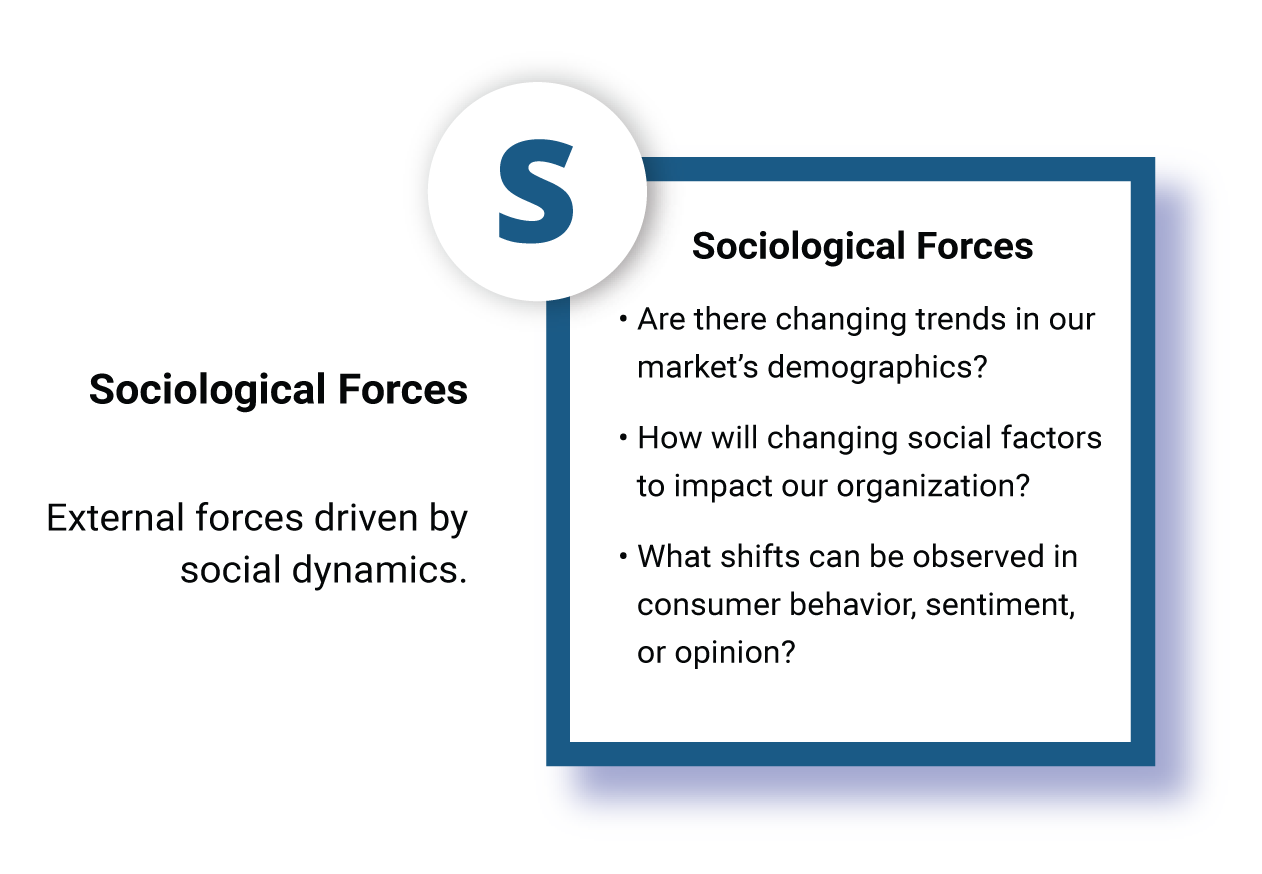
Sociological factors consider the changes in the greater social environment, such as social justice movements or other social trends like changing opinions on your product or shifting populations and demographics. It’s essential to consider sociological trends that are at play¬— not just in your organization’s immediate environment—but also in the broader environment that your customers are coming from.
Questions to ask:
- Are there changing trends in our market’s demographics or population? How best do we serve them?
- How are changing social factors going to impact our organization?
- What shifts can be observed in consumer behavior, sentiment, or opinion?
What are Technological factors?
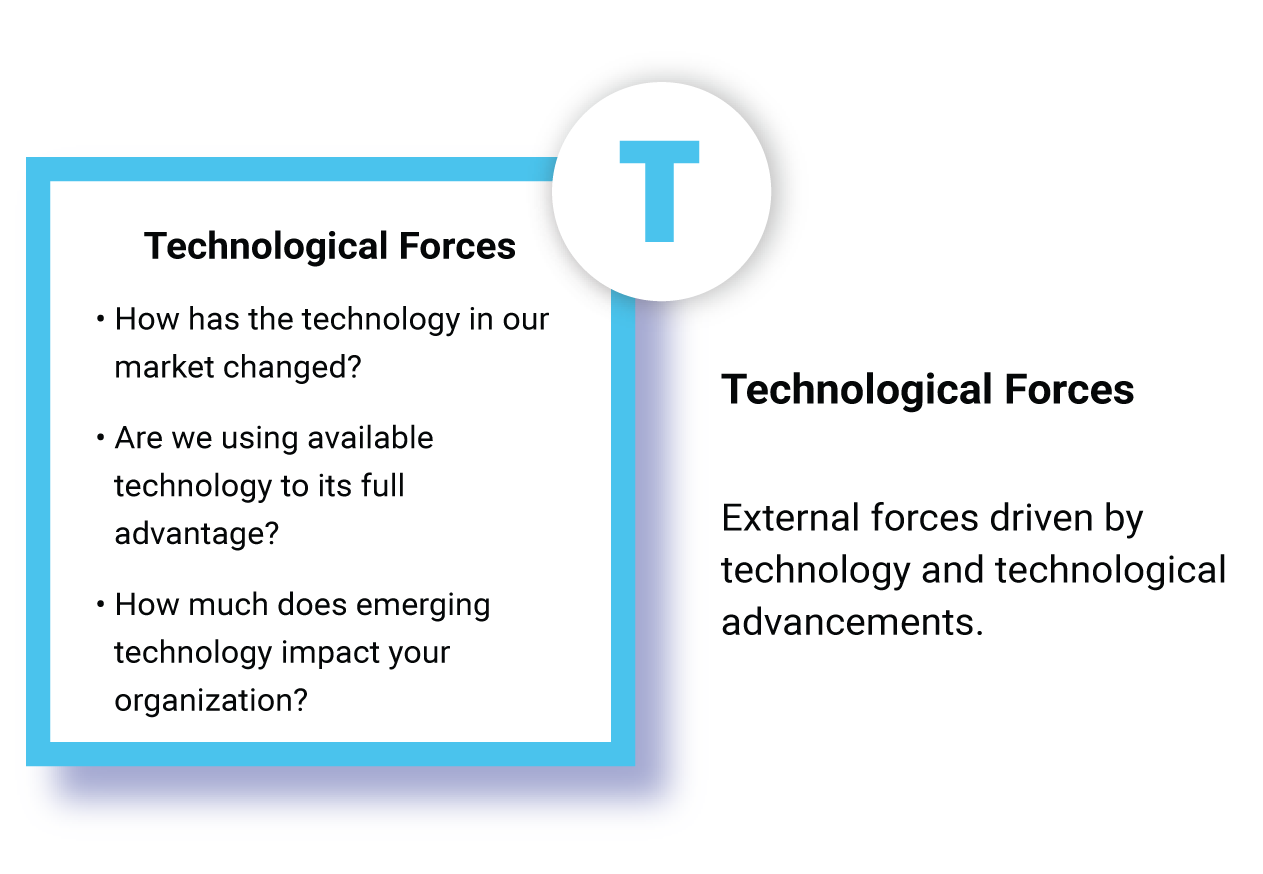
Changes in technology affect a business’s positioning. Some recent examples are the rise of cryptocurrency (which can also fall into the economic category), the emergence of popular work-from-home technology, AI developments, and even concerns over cyber security or other technological issues. It is important to consider how technology can prove to be both an opportunity for your organization, or a threat to it.
Questions to ask:
- How has the technology in our market changed? Is that an opportunity or threat?
- Are you using available technology to its full advantage?
- How much does emerging technology impact your organization?
What are Legal factors?
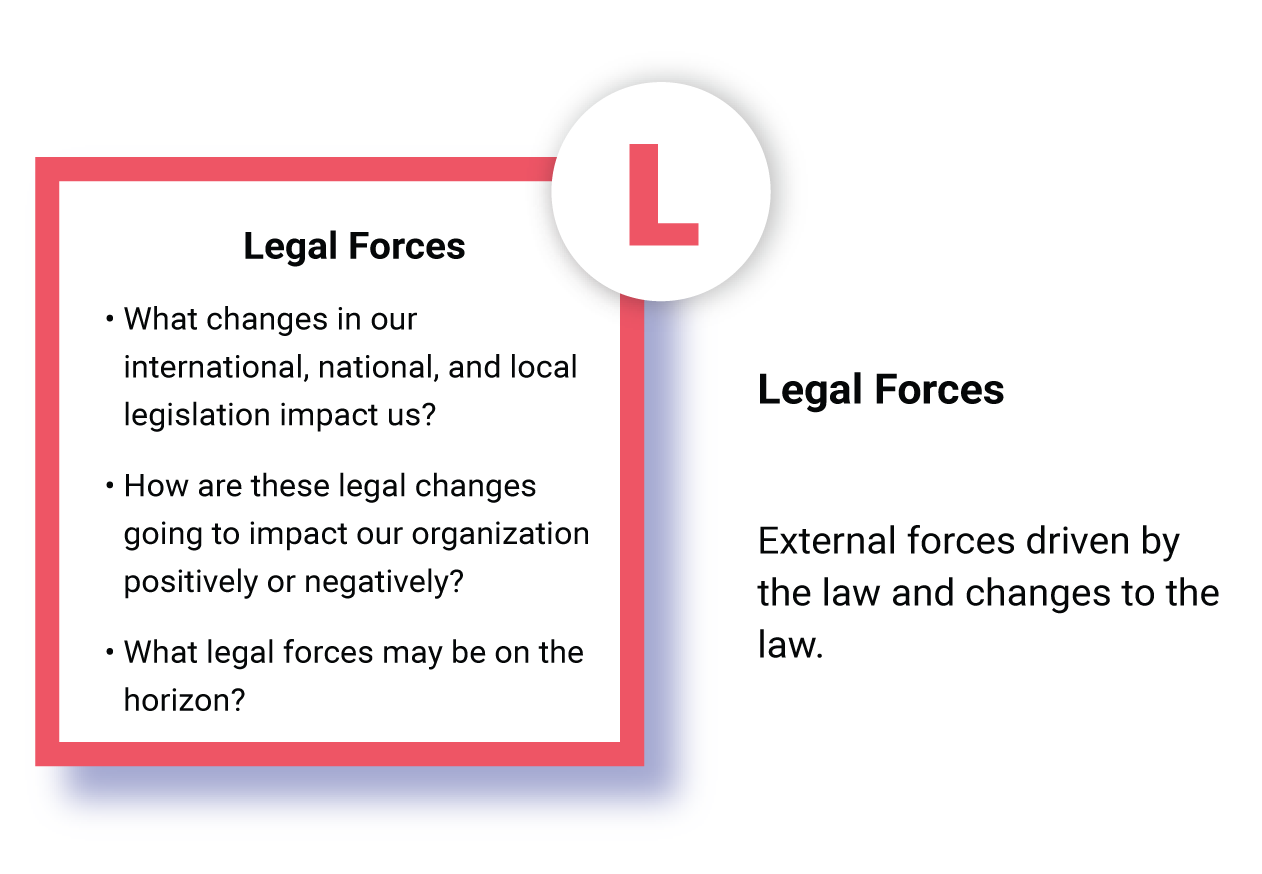
While similar to the political aspects, the legal elements look at the practical application of the political factors into rules and regulations that may affect your business or customers. These are the laws and regulations that impact your organization.
This could include updated laws, new regulations, or abolishing laws. Depending on your business, local, state, and federal laws and regulations are worth scrutinizing.
Questions to ask:
- What changes in our international, national, and local legislation impact our organization?
- How are these legal changes going to impact our organization positively or negatively?
- What legal forces may be on the horizon?
What are Environmental factors?
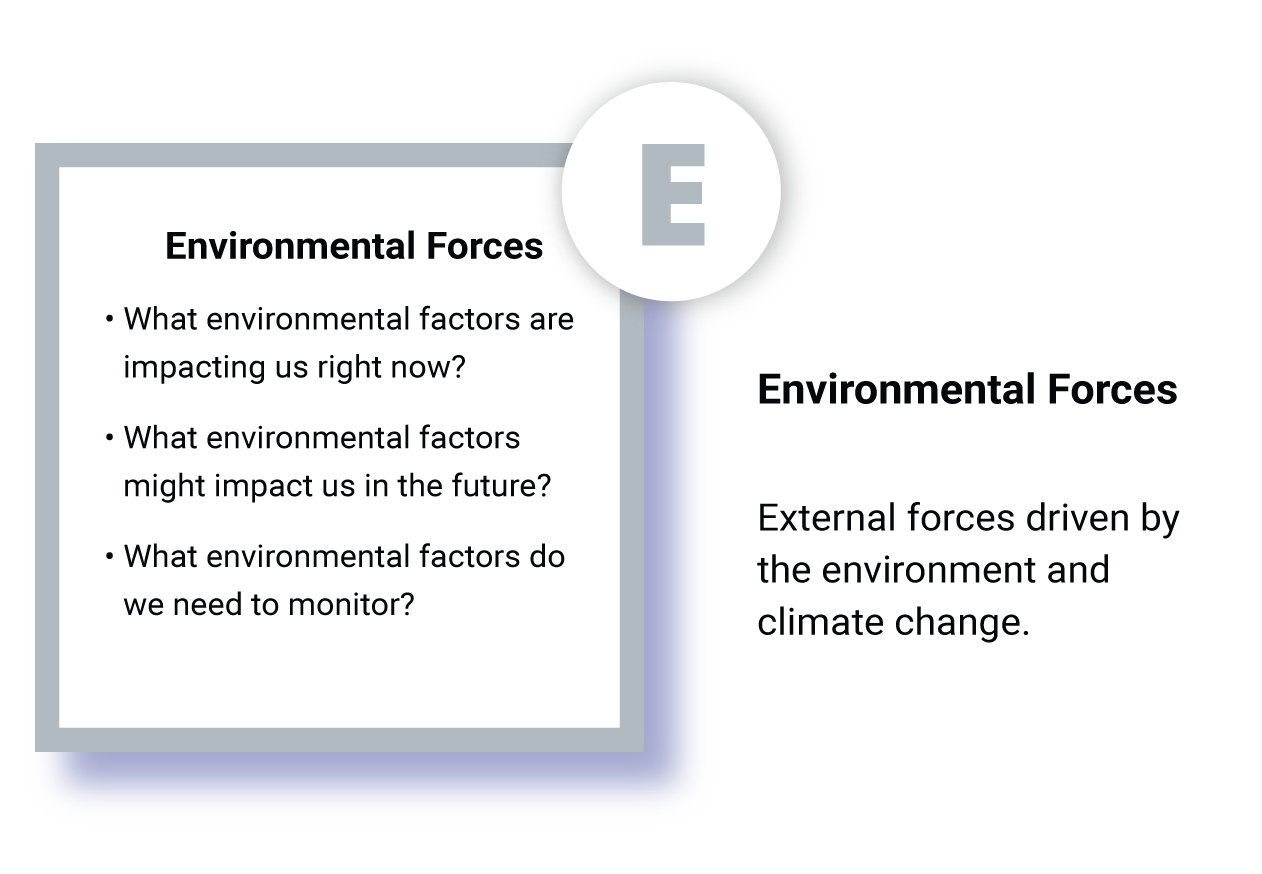
Environmental factors are affected by weather, geography, climate change, and health crises. In addition to the public health crisis caused by the COVID pandemic, the world has also been impacted by wildfires across the globe.
Organizations should consider the short-term and long-term impacts of these accelerating changes, e.g., rising ocean levels, drier and warmer seasons, and yearly weather conditions such as hurricanes and typhoons.
Questions to ask:
- What environmental factors are impacting us right now?
- What environmental factors might impact us in the future?
- What environmental factors do we need to monitor?
Bonus - What are Ethical factors?
Over the last few years, business and marketing strategy experts have added a third ‘E’ to the PESTLE- the ethical factor. This can include things such as fair-trade practices, child labor issues, even society’s increasing demand for conscious business models, and corporate social responsibility.
Questions to ask:
- What external ethics forces are impacting the market?
- What changes to your business or suppliers might you consider?
- What kind of impact or example do you hope your company may set?
Advantages and Disadvantages of a PESTLE Analysis
What are the advantages of using a PESTLE analysis?
There are several advantages to conducting a this analysis for your business. Here’s a breakdown:
- It is a simple and straightforward framework that is easy to implement into your strategic plan.
- It also allows you and your team to facilitate a great understanding of the wider business environment and how current events can potentially affect your business.
- Additionally, it helps organizations anticipate business threats and figure out how to mitigate the risks and it helps organizations spot business opportunities on which they can capitalize.
What are the disadvantages of using a PESTLE analysis?
While it’s a great tool, here are a few of the disadvantages to using this:
- One of the disadvantages of doing this type of assessment is that it can be as light or as heavy as one wants to make it.
- It is easy to oversimplify the data or collect insufficient data.
- It is also easy to make it too heavy by collecting too much data and becoming so overwhelmed that you don’t know where to start. This is a phenomenon called ‘analysis paralysis.’
- It’s a great tool, but it doesn’t analyze your organization’s internal strengths and weaknesses. That’s why we recommend using it in conjunction with your SWOT analysis.
Best Practices- When and How to Use this Assessment:
You should conduct your PESTLE analysis in the pre-planning stages of your business or strategic plan with a SWOT analysis. A SWOT analysis looks at your organization’s internal strengths and weaknesses and the external opportunities and threats the market presents. This will be an excellent companion piece to your SWOT as it informs your SWOT by looking at all aspects of the external market environment.
So, when conducting your analysis, break down each factor and look at both the positive aspects you can leverage (the opportunities) and the pitfalls to avoid (the threats) within the political, economic, social, technological, legal, and environmental spheres. If you want to see some real world examples, check out our PESTLE Analysis Examples.
While this exercise is typically conducted in the beginning stages of a strategic plan, it is best to set a regular cycle to check in and revisit it. With the speed at which things are constantly shifting and changing, the analysis you conducted five years ago may need to be revised today. It is best to update it at a minimum every three years. Or, when you update your SWOT. It can be helpful to look at these trends annually, too. Make it a habit to keep a pulse on current events and market changes, so you always know what is going on in your market and how it will affect your organization.
Conclusion: Where does PESTLE Analysis fit into strategic planning?
Leveraging your PESTLE analysis as the first step to your business and strategic planning process is the ultimate way to ensure that you know all the areas your business can capitalize on and which pitfalls you can work on to mitigate. This will help you get the complete picture of where your organization is playing and just what you need to ensure that you will win.
PESTLE Analysis FAQs
Link nội dung: https://pmil.edu.vn/pestle-a11989.html